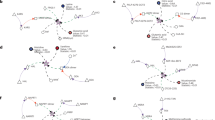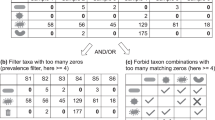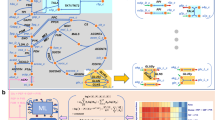Abstract
The computational reconstruction and analysis of cellular models of microbial metabolism is one of the great success stories of systems biology. The extent and quality of metabolic network reconstructions is, however, limited by the current state of biochemical knowledge. Can experimental high-throughput data be used to improve and expand network reconstructions to include unexplored areas of metabolism? Recent advances in experimental technology and analytical methods bring this aim an important step closer to realization. Data integration will play a particularly important part in exploiting the new experimental opportunities.
This is a preview of subscription content, access via your institution
Access options
Subscribe to this journal
Receive 12 print issues and online access
$209.00 per year
only $17.42 per issue
Buy this article
- Purchase on Springer Link
- Instant access to full article PDF
Prices may be subject to local taxes which are calculated during checkout



Similar content being viewed by others
References
Fleischmann, R. D. et al. Whole-genome random sequencing and assembly of Haemophilus influenzae Rd. Science 269, 496–512 (1995).
Price, N. D., Reed, J. L. & Palsson, B. Ø. Genome-scale models of microbial cells: evaluating the consequences of constraints. Nature Rev. Microbiol. 2, 886–897 (2004).
Notebaart, R. A., van Enckevort, F. H., Francke, C., Siezen, R. J. & Teusink, B. Accelerating the reconstruction of genome-scale metabolic networks. BMC Bioinformatics 7, 296 (2006).
Reed, J. L., Famili, I., Thiele, I. & Palsson, B. O. Towards multidimensional genome annotation. Nature Rev. Genet. 7, 130–141 (2006).
Ma, H. & Zeng, A. P. Reconstruction of metabolic networks from genome data and analysis of their global structure for various organisms. Bioinformatics 19, 270–277 (2003).
Kanehisa, M. et al. From genomics to chemical genomics: new developments in KEGG. Nucleic Acids Res. 34, D354–D357 (2006).
Caspi, R. et al. MetaCyc: a multiorganism database of metabolic pathways and enzymes. Nucleic Acids Res. 34, D511–D516 (2006).
Feist, A. M., Scholten, J. C., Palsson, B. O., Brockman, F. J. & Ideker, T. Modeling methanogenesis with a genome-scale metabolic reconstruction of Methanosarcina barkeri. Mol. Syst. Biol. [online], (2006).
Mahadevan, R. et al. Characterization of metabolism in the Fe(III)-reducing organism Geobacter sulfurreducens by constraint-based modeling. Appl. Environ. Microbiol. 72, 1558–1568 (2006).
Kharchenko, P., Chen, L., Freund, Y., Vitkup, D. & Church, G. M. Identifying metabolic enzymes with multiple types of association evidence. BMC Bioinformatics 7, 177 (2006).
Kharchenko, P., Vitkup, D. & Church, G. M. Filling gaps in a metabolic network using expression information. Bioinformatics 20, (Suppl. 1), I178–I185 (2004).
Green, M. L. & Karp, P. D. A Bayesian method for identifying missing enzymes in predicted metabolic pathway databases. BMC Bioinformatics 5, 76 (2004).
Chen, L. & Vitkup, D. Distribution of orphan metabolic activities. Trends Biotechnol. 25, 343–348 (2007).
Lespinet, O. & Labedan, B. Orphan enzymes? Science 307, 42 (2005).
Fiehn, O. & Weckwerth, W. Deciphering metabolic networks. Eur. J. Biochem. 270, 579–588 (2003).
Fischer, E. & Sauer, U. A novel metabolic cycle catalyzes glucose oxidation and anaplerosis in hungry Escherichia coli. J. Biol. Chem. 278, 46446–46451 (2003).
Loh, K. D. et al. A previously undescribed pathway for pyrimidine catabolism. Proc. Natl Acad. Sci. USA 103, 5114–5119 (2006).
Breitling, R., Pitt, A. R. & Barrett, M. P. Precision mapping of the metabolome. Trends Biotechnol. 24, 543–548 (2006).
Dettmer, K., Aronov, P. A. & Hammock, B. D. Mass spectrometry-based metabolomics. Mass Spectrom. Rev. 26, 51–78 (2007).
Dunn, W. B., Bailey, N. J. & Johnson, H. E. Measuring the metabolome: current analytical technologies. Analyst 130, 606–625 (2005).
Hollywood, K., Brison, D. R. & Goodacre, R. Metabolomics: current technologies and future trends. Proteomics 6, 4716–4723 (2006).
Want, E. J., Nordstrom, A., Morita, H. & Siuzdak, G. From exogenous to endogenous: the inevitable imprint of mass spectrometry in metabolomics. J. Proteome Res. 6, 459–468 (2007).
Hu, Q. et al. The Orbitrap: a new mass spectrometer. J. Mass Spectrom. 40, 430–443 (2005).
Makarov, A., Denisov, E., Lange, O. & Horning, S. Dynamic range of mass accuracy in LTQ Orbitrap hybrid mass spectrometer. J. Am. Soc. Mass Spectrom. 17, 977–982 (2006).
Brown, S. C., Kruppa, G. & Dasseux, J. L. Metabolomics applications of FT-ICR mass spectrometry. Mass Spectrom. Rev. 24, 223–231 (2005).
Koulman, A. et al. High-throughput direct-infusion ion trap mass spectrometry: a new method for metabolomics. Rapid Commun. Mass Spectrom. 21, 421–428 (2007).
Aharoni, A. et al. Nontargeted metabolome analysis by use of Fourier Transform Ion Cyclotron Mass Spectrometry. OMICS 6, 217–234 (2002).
Breitling, R., Ritchie, S., Goodenowe, D., Stewart, M. L. & Barrett, M. P. Ab initio prediction of metabolic networks using Fourier transform mass spectrometry data. Metabolomics 2, 155–164 (2006).
Nobeli, I., Ponstingl, H., Krissinel, E. B. & Thornton, J. M. A structure-based anatomy of the E.coli metabolome. J. Mol. Biol. 334, 697–719 (2003).
Arkin, A., Shen, P. & Ross, J. A test case of correlation metric construction of a reaction pathway from measurements. Science 277, 1275–1279 (1997).
Vance, W., Arkin, A. & Ross, J. Determination of causal connectivities of species in reaction networks. Proc. Natl Acad. Sci. USA 99, 5816–5821 (2002).
Torralba, A. S., Yu, K., Shen, P., Oefner, P. J. & Ross, J. Experimental test of a method for determining causal connectivities of species in reactions. Proc. Natl Acad. Sci. USA 100, 1494–1498 (2003).
Fiehn, O. et al. Metabolite profiling for plant functional genomics. Nature Biotechnol. 18, 1157–1161 (2000).
Camacho, D., de la Fuente, A. & Mendes, P. The origin of correlations in metabolomics data. Metabolomics 1, 53–63 (2005).
Steuer, R. On the analysis and interpretation of correlations in metabolomic data. Brief. Bioinform. 7, 151–158 (2006).
Steuer, R., Kurths, J., Fiehn, O. & Weckwerth, W. Interpreting correlations in metabolomic networks. Biochem. Soc. Trans. 31, 1476–1478 (2003).
Steuer, R., Kurths, J., Fiehn, O. & Weckwerth, W. Observing and interpreting correlations in metabolomic networks. Bioinformatics 19, 1019–1026 (2003).
Voit, E. O., Marino, S. & Lall, R. Challenges for the identification of biological systems from in vivo time series data. In Silico Biol. 5, 83–92 (2005).
Jansen, R. C. & Nap, J. P. Genetical genomics: the added value from segregation. Trends Genet. 17, 388–391 (2001).
Keurentjes, J. J. et al. The genetics of plant metabolism. Nature Genet. 38, 842–849 (2006).
Fu, J., Swertz, M., Keurentjes, J. & Jansen, R. MetaNetwork: a computational protocol for the genetic study of metabolic networks. Nature Protoc. 2, 685–694 (2007).
Brem, R. B., Yvert, G., Clinton, R. & Kruglyak, L. Genetic dissection of transcriptional regulation in budding yeast. Science 296, 752–755 (2002).
Cheung, V. G. et al. Mapping determinants of human gene expression by regional and genome-wide association. Nature 437, 1365–1369 (2005).
Sauer, U. High-throughput phenomics: experimental methods for mapping fluxomes. Curr. Opin. Biotechnol. 15, 58–63 (2004).
Sauer, U. Metabolic networks in motion: 13C-based flux analysis. Mol. Syst. Biol. [online], (2006).
Herrgard, M. J., Fong, S. S. & Palsson, B. O. Identification of genome-scale metabolic network models using experimentally measured flux profiles. PLoS Comput. Biol. 2, e72 (2006).
Dudley, A. M., Janse, D. M., Tanay, A., Shamir, R. & Church, G. M. A global view of pleiotropy and phenotypically derived gene function in yeast. Mol. Syst. Biol. [online], (2005).
Forster, J., Famili, I., Fu, P., Palsson, B. O. & Nielsen, J. Genome-scale reconstruction of the Saccharomyces cerevisiae metabolic network. Genome Res. 13, 244–253 (2003).
Reed, J. L., Vo, T. D., Schilling, C. H. & Palsson, B. O. An expanded genome-scale model of Escherichia coli K-12 (iJR904 GSM/GPR). Genome Biol. 4, R54 (2003).
Kuepfer, L., Sauer, U. & Blank, L. M. Metabolic functions of duplicate genes in Saccharomyces cerevisiae. Genome Res. 15, 1421–1430 (2005).
Oh, Y. K., Palsson, B. O., Park, S. M., Schilling, C. H. & Mahadevan, R. Genome-scale reconstruction of metabolic network in Bacillus subtilis based on high-throughput phenotyping and gene essentiality data. J. Biol. Chem. 282, 28791–28799 (2007).
Reed, J. L. et al. Systems approach to refining genome annotation. Proc. Natl Acad. Sci. USA 103, 17480–17484 (2006).
Kumar, V. S., Dasika, M. S. & Maranas, C. D. Optimization based automated curation of metabolic reconstructions. BMC Bioinformatics 8, 212 (2007).
Kümmel, A., Panke, S. & Heinemann, M. Putative regulatory sites unraveled by network-embedded thermodynamic analysis of metabolome data. Mol. Syst. Biol. [online], (2006).
Guimera, R. & Nunes Amaral, L. A. Functional cartography of complex metabolic networks. Nature 433, 895–900 (2005).
Pal, C., Papp, B. & Lercher, M. J. Adaptive evolution of bacterial metabolic networks by horizontal gene transfer. Nature Genet. 37, 1372–1375 (2005).
Csete, M. & Doyle, J. Bow ties, metabolism and disease. Trends Biotechnol. 22, 446–450 (2004).
Clardy, J., Fischbach, M. A. & Walsh, C. T. New antibiotics from bacterial natural products. Nature Biotechnol. 24, 1541–1550 (2006).
Fischbach, M. A. & Walsh, C. T. Biochemistry: directing biosynthesis. Science 314, 603–605 (2006).
Jansen, R. et al. A Bayesian networks approach for predicting protein–protein interactions from genomic data. Science 302, 449–453 (2003).
Marcotte, E. M., Pellegrini, M., Thompson, M. J., Yeates, T. O. & Eisenberg, D. A combined algorithm for genome-wide prediction of protein function. Nature 402, 83–86 (1999).
Fong, S. S. & Palsson, B. O. Metabolic gene-deletion strains of Escherichia coli evolve to computationally predicted growth phenotypes. Nature Genet. 36, 1056–1058 (2004).
Ibarra, R. U., Edwards, J. S. & Palsson, B. O. Escherichia coli K-12 undergoes adaptive evolution to achieve in silico predicted optimal growth. Nature 420, 186–189 (2002).
Fong, S. S., Nanchen, A., Palsson, B. O. & Sauer, U. Latent pathway activation and increased pathway capacity enable Escherichia coli adaptation to loss of key metabolic enzymes. J. Biol. Chem. 281, 8024–8033 (2006).
Segre, D., Vitkup, D. & Church, G. M. Analysis of optimality in natural and perturbed metabolic networks. Proc. Natl Acad. Sci. USA 99, 15112–15117 (2002).
Burgard, A. P., Pharkya, P. & Maranas, C. D. Optknock: a bilevel programming framework for identifying gene knockout strategies for microbial strain optimization. Biotechnol. Bioeng. 84, 647–657 (2003).
Fong, S. S. et al. In silico design and adaptive evolution of Escherichia coli for production of lactic acid. Biotechnol. Bioeng. 91, 643–648 (2005).
Acknowledgements
The authors thank M. Spitzer, J. Wildenhain, M. Swertz, R. Jansen, J. Fu, Y. Li, E. Takano, D. Höller and R. Steuer for their constructive comments on the manuscript. We apologize to those authors whose relevant work we could not cite owing to space constraints.
Author information
Authors and Affiliations
Corresponding authors
Related links
Related links
DATABASES
Entrez Genome Project
FURTHER INFORMATION
Glossary
- De novo pathway reconstruction
-
The inference of metabolic pathways directly from experimental measurements, without any prior information.
- Emergent property
-
A property that emerges only in the context of an integrated system, not in its components; also called systems property.
- Flux-balance analysis
-
A computational method that is used to obtain feasible flux distributions in metabolic networks. Linear constraints on nutrient uptake, reaction irreversibility and steady-state conservation of metabolite concentrations are applied using a stoichiometric model. The fluxes that are optimal for a given objective function (for example, biomass production or ATP synthesis) are then obtained using linear optimization.
- Genetical genomics
-
The combination of high-throughput measurements of gene expression, protein levels or metabolite concentrations with classical genetic strategies.
- Metabolomics
-
The analysis of the concentration and dynamics of small cellular molecules (the metabolome).
- Optimal metabolic network identification
-
(OMNI). A computational method for correcting stoichiometric models based on a small number of pathway flux measurements.
- Stable-isotope flux analysis
-
An analysis that traces the metabolic fate of non-radioactive atoms from labelled precursors to biomass components. The steady-state labelling pattern can be used to infer the activity of metabolic pathways (fluxes) with the help of stoichiometric models.
- Stoichiometric model
-
A detailed description of metabolism without information on the kinetic or thermodynamic parameters. The model specifies how many molecules of each substrate are used and how many product molecules are generated (the reaction stoichiometry) for every reaction.
Rights and permissions
About this article
Cite this article
Breitling, R., Vitkup, D. & Barrett, M. New surveyor tools for charting microbial metabolic maps. Nat Rev Microbiol 6, 156–161 (2008). https://doi.org/10.1038/nrmicro1797
Issue Date:
DOI: https://doi.org/10.1038/nrmicro1797
This article is cited by
-
Stable isotope-assisted metabolite profiling reveals new insights into L-tryptophan chemotrophic metabolism of Rubrivivax benzoatilyticus
World Journal of Microbiology and Biotechnology (2023)
-
Streptomyces: host for refactoring of diverse bioactive secondary metabolites
3 Biotech (2021)
-
Molecular cartography in acute Chlamydia pneumoniae infections—a non-targeted metabolomics approach
Analytical and Bioanalytical Chemistry (2013)
-
MIRAGE: a functional genomics-based approach for metabolic network model reconstruction and its application to cyanobacteria networks
Genome Biology (2012)
-
Computational tools for the synthetic design of biochemical pathways
Nature Reviews Microbiology (2012)



